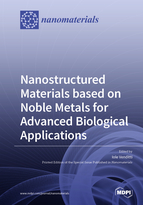Nanostructured Materials based on Noble Metals for Advanced Biological Applications
A special issue of Nanomaterials (ISSN 2079-4991).
Deadline for manuscript submissions: closed (30 June 2019) | Viewed by 61808
Special Issue Editor
Interests: nanomaterials; inorganic chemistry; drug delivery; sensing; optical materials; photonics
Special Issues, Collections and Topics in MDPI journals
Special Issue Information
Dear Colleagues,
In these recent years, many efforts have been devoted to developing nanostructured materials, based on noble metals, for biological applications.
In fact, nanodimension is the strategic key for a wide range of bio-applications, such as biosensors, biocatalysis, drug delivery, imaging and theranostic applications.
A huge variety of new materials and composites have been improved, mainly via chemical approaches, using metal surface engineering to build new synergic hybrid systems.
This Special Issue focuses on highlighting the progress of new nanostrucuted materials, based on noble metals, their preparation, functionalization, characterization and advanced application in biological fields.
We invite you to submit a manuscript for this Special Issue. Full papers, communications, and reviews are all welcome.
Dr. Iole Venditti
Guest Editor
Manuscript Submission Information
Manuscripts should be submitted online at www.mdpi.com by registering and logging in to this website. Once you are registered, click here to go to the submission form. Manuscripts can be submitted until the deadline. All submissions that pass pre-check are peer-reviewed. Accepted papers will be published continuously in the journal (as soon as accepted) and will be listed together on the special issue website. Research articles, review articles as well as short communications are invited. For planned papers, a title and short abstract (about 100 words) can be sent to the Editorial Office for announcement on this website.
Submitted manuscripts should not have been published previously, nor be under consideration for publication elsewhere (except conference proceedings papers). All manuscripts are thoroughly refereed through a single-blind peer-review process. A guide for authors and other relevant information for submission of manuscripts is available on the Instructions for Authors page. Nanomaterials is an international peer-reviewed open access semimonthly journal published by MDPI.
Please visit the Instructions for Authors page before submitting a manuscript. The Article Processing Charge (APC) for publication in this open access journal is 2900 CHF (Swiss Francs). Submitted papers should be well formatted and use good English. Authors may use MDPI's English editing service prior to publication or during author revisions.
Keywords
- noble metal nano-objects (nanoparticles, nanorods, nanocages, and so on)
- synthesis of noble metal nano-objects
- functionalized noble metal nano-objects
- biosensors
- sensors
- biocatalysis
- drug delivery
- imaging
- theranostic
- nanomedicine







